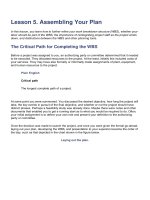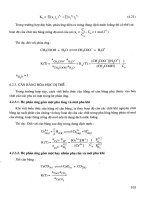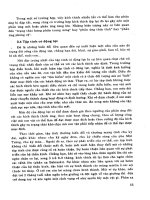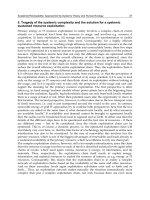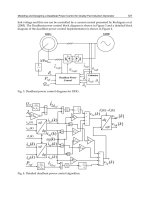Wind Energy Management Part 3 doc
Bạn đang xem bản rút gọn của tài liệu. Xem và tải ngay bản đầy đủ của tài liệu tại đây (4.5 MB, 13 trang )
Optimizing Habitat Models as a Means for Resolving
Environmental Barriers for Wind Farm Developments in the Marine Environment
17
In the environmental programmes related to two of the latest large-scale offshore wind farm
project; Horns Rev 2 (2008-2010) and Anholt (2009-2010) DHI used the MIKE modelling
framework (Rasmussen, 1991) to facilitate easy and seamless linking of all models required
for the full implementation of a local model in relation to the various aspects of the
feasibility, construction and operation of the wind farm. The MIKE modelling framework
links the basic hydrodynamic and wave modules to the different modules applied for
sedimentation processes, water quality, and benthic pelagic environmental conditions. The
water level variation and flows are simulated in response to a variety of forcing functions
using a stratified model, MIKE3 (DHI Water & Environment, 2000). The water levels and
flows are resolved on an array of nested regular grids.
Benthic habitat models have been developed reflecting the links between the variability of
the long-lived elements and bio-coenoces of benthic communities in the regions
surrounding the sites in the central Kattegat and the North Sea, and measured/modelled
parameters like water depth, sediment, sediment grain size, water temperature, oxygen
level, contents of organic matter, light attenuation, plankton density, density of suspended
material in the water column etc. The resulting statistical species distribution models are
directly coupled to the refined hydrodynamic models which produced temporally resolved
predictions of local distribution changes of benthic fauna and flora resulting from natural
changes in oceanographic conditions. The statistical models could then be used as a basis for
evaluating the change in the distribution of target animals and communities, and the
relation to the natural variability of the local ecosystem.
The baseline, impact assessment and monitoring studies carried out in relation to the Horns
Rev 2 (Leonhard, 2006; Skov & Thomsen, 2006; Skov et al., 2008) and Anholt (Møhlenberg,
2009; Skov et al., 2009) projects highlighted the benefits of adding model data to the results
from traditional surveys. The baseline conditions are used as a yardstick to evaluate the
permanent changes in benthic habitats following establishment of the wind farms, and
temporal effects related to earth works. The merits of using combined hydrodynamic,
sediment and biological models as a basis for estimation of environmental impacts can be
summarised as:
Estimation of the realistic scale of impacts;
Identification of hydrographic and geomorphologic structures and habitats and
estimation of their variability;
Increase of power of sampled data by provision of physio-chemical data;
Improvement of understanding of the local dynamics of project site and hence
interpretation of changes - especially in relation to regional scale events;
Evaluation of the similarity of reference and impact sites, incl. re-assessment of the
location of the reference areas;
Evaluation of the extent of the monitoring design in relation to the (modelled) level of
impact in monitored areas.
4. Application for offshore wind farm developments
The model design applied for the Horns Rev 2 and Anholt offshore wind farms is based on
four model elements:
1. A regional and local hydrodynamic model;
2. An ecological model;
3. A deterministic filter-feeder model;
4. A habitat suitability model.
Wind Energy Management
18
4.1 Hydrodynamic model
Several numerical 3D flow models have been established within the MIKE modelling
framework covering the North Sea and Kattegat. Each of these models has individual
strengths. With the purpose of water quality modelling, the so-called BANSAI model (DHI,
2006) was chosen as it has been running operationally since 2001. The model provides input
data with regard to the flow field and water quality, and consists of two parts:
A hydrodynamic module for calculating the evolution in water levels, currents, salinity,
and water temperature.
An ecological module that calculates the spreading of nutrients, the primary
production, the biomass, and other ecological parameters.
The main objective of this integrated model system is to calculate the environmental status
in the area of the wind farm sites. This includes source apportioning, transport, dispersion,
transformation and removal in the coastal and open sea marine waters of nutrients inputs to
the North and Baltic Seas. Originally the BANSAI model was created in a collaboration
between the Swedish Meteorological and Hydrological Institute (SMHI, Sweden), Finnish
Institute of Marine Research (FIMR) and DHI.
Fig. 1. Example of boundaries and nesting used in the habitat model system for the Anholt
offshore wind farm.
The model is using DHI’s 3-dimensional model system MIKE3 Classic, which is a fully
three-dimensional, non-hydrostatic, primitive equation model (Rasmussen, 1991). It is based
on the Reynolds-averaged Navier-Stokes equations and the conservation of mass, salinity
and temperature. The prognostic variables are fluid pressure, the three velocity components
and the two scalar quantities salt and temperature. In the waters nearest Denmark (the
eastern part of the North Sea, Skagerrak, Kattegat, the Belts and the western Baltic) a 3
nautical miles grid is used while a 9 nautical miles grid is used in the North Sea and in the
eastern Baltic Sea. The local model applied has this resolution in the outer mesh but by use
of the nesting technique this is downscaled by a factor 9 to a resolution of app. 600 m in the
area of interest where the wind mills are located. The distance between the wind mills is 600
Optimizing Habitat Models as a Means for Resolving
Environmental Barriers for Wind Farm Developments in the Marine Environment
19
m – 700 m which means that there will be approximately one wind turbine in each cell in the
model area.
The model represents the water column with a 2 m resolution. The model is operational and
based on:
Meteorology;
Tide, salinity-, temperature and nutrients on the edge of the Atlantic (tide from tidal
constituents, salinity and temperature from monthly climatology (ICES), nutrients from
climatology supplied with national monitoring data from Denmark and Germany;
Runoff and nutrient loadings from land (runoff from monthly climatology from
HELCOM, OSPAR, national monitoring data) and nutrient loadings from climatology
supplied with national monitoring data.
The model was first calibrated based on measurements from the year 2000 and has been
continuously improved since then. The representation of salinity in the Belts is extremely
important for ecological modelling in the Kattegat, whereas the representation of currents is
the key to obtain correct ecological conditions in the eastern part of the North Sea.
4.2 Ecological model
The ecological model consists of an eutrophication model describing the pelagic system with
13 state variables, and seven state variables describing the exchangeable Nitrogen and
Phosphorous pools in the sediment (Rasmussen et al., 2009). The pelagic system includes
phytoplankton, described in terms of their concentration of carbon (C), nitrogen (N) and
phosphorus (P), chlorophyll-a, zooplankton, detritus (C, N & P), inorganic nutrients
(dissolved inorganic nitrogen—DIN & PO4–P), total N and P nutrients (including dissolved
organic N and P compounds) and dissolved Oxygen (DO). Due to the depth in the wind
farm development areas benthic vegetation (i.e. macroalgae) is poorly developed or not
existing, and accordingly benthic vegetation is not included in the model. In addition to
state variables a large suite of derived variables such as water transparency and secchi
depth is modelled and stored during the modelling process. Benthic organisms are not
modelled explicitly, but are included as a forcing in the water quality model. Filter-feeding
bivalves constitute on average 93% of the entire biomass of benthic invertebrates in the
areas, and their filtering activity can exert a significant grazing loss on phytoplankton. Their
effect is included in the model by imposing a filtration loss on phytoplankton and detritus in
the near bed model layer according to the filtration capacity calculated from length
distribution and total biomass of the different species. Because bivalves are not included as a
state-variable they do not participate directly in nutrient cycling and accordingly, 50% of
filtered algae (C,N,P) are returned as inorganic solutes to the near-bed layer and 50% are
entered into the detritus pool subject to sedimentation and remineralisation. Figure 2 shows
the state variables and processes for carbon (C) for the pelagic system.
The ecological model was built using the generic equation solver ECOLab that functions as a
module in the MIKE 3 simulation software, and ECOLab is linked to the advection-
dispersion term of the hydrodynamic flow model, enabling transport mechanisms based on
advection-dispersion to be seamlessly integrated into the ECO Lab simulation.
Forcings and boundary conditions of the water quality model follows the line of the forcings
and boundaries of the hydrodynamic model, but in addition values for all pelagic state
variables at boundaries (Øresund, Southern Kattegat and north of Læsø) and nutrient
concentrations in freshwater loads (monthly basis) in addition to atmospheric loads are
Wind Energy Management
20
included. Boundary values are forced with water quality data extracted from the BANSAI
model.
Fig. 2. Schematic diagram showing state variables and processes for carbon in the ecological
model established to simulate water quality.
4.3 Filter-feeder model
Carrying capacity models for filter-feeders (FF) were established for epibenthic filter-feeding
bivalves exemplified by Mytilus edulis and Modiolus modiolus and infauna filter-feeding
bivalves exemplified by Arctica islandica and Spisula subtruncata in the Kattegat and infauna
filter-feeding bivalves in the North Sea exemplified by Ensis americanus and Spisula
subtruncata using the output from the hydrodynamic and water quality models. The FF
models build on the same concept by combining a physiology-based growth and survival
model for a standard individual with an advection term that replenish the food ingested by
filter-feeders. On a large scale benthic FF for filter-feeders depends on the local primary
production and on smaller scale current speed plays an increasing role for FF.
The energy balance of a filter-feeding bivalve can be expressed as: I = P + R
t
+ F, where I =
ingestion; P = growth, R
t
= total respiration (sum of maintenance respiration, R
m
, and
respiratory cost of growth, R
g
), and F = excretion. Rearranging, growth is expressed as P = I
x AE - (R
m
+ R
g
) or P = (F x C x AE) - (R
m
+ R
g
), where AE = (I - F)/I = assimilation efficiency,
F = filtration rate, and C = algal concentration. In the individual bivalve growth depends on
the quantity (C) and quality of suspended food particles including different species of algae,
ciliates and zooplankton organisms along with suspended inorganic material (silt). The
maintenance food concentration (which just is sufficient for zero growth) and the maximum
growth rate for a standard-sized bivalve differs between species and between populations
within species as result of adaptation to local composition and concentration of food
(Kiørboe & Møhlenberg, 1981). Energetic growth models are available for many filter-
feeders, including Spisula subtruncata (Kiørboe et al., 1980) and Mytilus edulis (Møhlenerg &
Kiørboe, 1981, Kiørboe et al., 1981).
Optimizing Habitat Models as a Means for Resolving
Environmental Barriers for Wind Farm Developments in the Marine Environment
21
Fig. 3. Comparison of functional response in Spisula subtruncata and Mytilus edulis.
Important documented evidence for food requirements for Spisula subtruncata (Figure 2)
includes a rather high maintenance food concentration of 0.072 mgC/l, and that suspended
bottom material (i.e. detritus) can constitute up to 30% of assimilated food (Kiørboe et al.
(1981). Based on the modelled detritus concentration in the model areas 5% of detritus was
assumed to be available for assimilation, hence a growth equation fitted to observed data
was developed using non-linear curve-fitting:
For food concentration (PC +0.05*DC) less than 0.072 mg C/l:
Gf = 2.55*(PC+0.05*DC-0.1833)
For food concentration (PC +0.05*DC) above 0.072 mg C/l:
Gf = (PC+0.05*DC-0.072)/(PC+0.05*DC-0.057))
The growth functions described above relate to individual bivalves surrounded by food at
constant concentrations. In nature, filter-feeding bivalves aggregate in dense assemblages if
current speeds are high, e.g. in tidal areas such as in the Wadden Sea. In low-current
environments plankton algae removed by filtration are only slowly replenished and such
environments cannot sustain dense populations. Therefore, the growth functions need to be
supplemented by an equation that describes the replenishment of food. In Mytilus the in situ
growth rate increases with current speed (Riisgård et al., 1994) and wind-induced
turbulence (Sand-Jensen et al., 1994). As bivalves in benthic environments consisting of
erodible substrate such as sand cannot maintain their position at current speeds larger than
0.6-1.0 m s
-1
a bell-shaped current function with an optimum speed at 0.3 m s
-1
was
constructed (Figure 4).
The individual growth function can then be combined with the current function to a
‘carrying capacity’ index reflecting both individual growth conditions and the density of
bivalves that can be sustained:
‘CC’-index = Gf * Vf
Controlled experiments of the effects of current speed on growth have only been carried out
on oysters, which showed an increase until an optimal current speed of 15 cm s
-1
, after
-0,4
-0,2
0
0,2
0,4
0,6
0,8
0 0,05 0,1 0,15 0,2
Relative growth rate
Food concentration (mg C/l)
Functional response in filter-feeding bivalves
Mytilus
Spisula
Wind Energy Management
22
which the growth started decreasing. Other bivalve species such as blue mussels increase
growth in the field with increasing current speed and wind-induced turbulence until a
plateau. This is generally interpreted as a consequence of increasing food availability.
Mussels which are settled on substrate like cliffs, stones and foundations may survive and
grow in even very energy rich environments (e.g. in current speeds > 60-80 cm s
-1
), while
blue mussels on sandy sediments are unable to establish long-living populations at current
speeds exceeding 40-50 cm s
-1
, probably as a result of erosion.
Fig. 4. Current function to describe food replenishment and physical stress in filter-feeding
bivalves.
Extended periods with low oxygen concentration can reduce growth and increase mortality
in benthic invertebrates including filter-feeders. Such information is included numerically
by multiplying the CC-index with a factor (0.8-0.9) for each day oxygen concentration is
below 2 mg O
2
/l but starting the reduction at day 7 with low oxygen. Also a salinity-
dependent function (species-specific) is included in the combined index:
FF-Index=CC index* SF*OF
SF denotes a species dependent salinity index and OF denotes a species independent oxygen
index. SF attains values below 1 at salinities less than 20 psu.
The final index for Mytilus edulis type in the central Kattegat is shown in Figure 5 for the six
years between 2000 and 2005. In general, the index is rather high in the shallow areas at
depths less than 12-13 m, whereas at depths larger than 15 m, i.e. where the seabed is
located below the pycnocline, the index is rather low due to lower chlorophyll
concentrations and lower current speeds. The time series documents a striking stability in
the patterns of benthic productivity in the Central Kattegat, and underlines that despite
variations the location of the planned Anholt offshore wind farm is always coinciding with
the benthic areas of lower productivity.
The model time series of benthic productivity provided a solid basis for the assessment of
the importance of the wind farm area to waterbirds. Both baseline and historic survey data
unambiguously point at the fact that the waterbirds do not use the wind farm and
associated areas with lower carrying capacity for filter-feeding bivalves to any great extent
(Figure 6). The areas of high carrying capacity for mussel growth (> 0.15), which match
Vf = 3*v*exp(1-3*v/0.67)/0.67
0,0
0,2
0,4
0,6
0,8
1,0
1,2
0 0,2 0,4 0,6 0,8 1 1,2 1,4
Current speed - m s
-1
Current function (relative)
Optimizing Habitat Models as a Means for Resolving
Environmental Barriers for Wind Farm Developments in the Marine Environment
23
exactly the most sensitive areas to the waterbirds in the Central Kattegat are located at a
minimum distance of 8 km from the wind farm site.
Fig. 5. Modelled mean and annual filter-feeder carrying capacity index for Mytilus edulis in
the central Kattegat between 2000 and 2005. The planned site for the Anholt offshore wind
farm is indicated.
4.4 Habitat suitability model
On Horns Rev, in the North Sea, habitat suitability models were developed on top of the
filter-feeder models in order to estimate more precisely the distribution of the two in-fauna
bivalves Spisula subtruncata and Ensis americanus; two key species in the benthic ecosystem
of the eastern North Sea whose distribution can only be estimated by the addition of geo-
morphological parameters. This was done within the frame of habitat suitability modelling
using empirical samples of the two species as response variables and modeled filter-feeder
indices, sediment data and data on the depth and relief of the sea floor as predictor
Wind Energy Management
24
variables. All variables were standardized using ‘Box-Cox’ normalization (Sokal and Rohlf,
1981), and suitability functions were computed using Ecological Niche Factor Analysis
(Hirzel et al., 2002).
Fig. 6. Index of abundance of waterbirds during winter (species occurring in internationally
important concentrations) in the Central Kattegat. The scale is arbitrary. The planned site for
the Anholt offshore wind farm is indicated.
Suitability functions compare the distribution of razor clams and trough shells in the
multivariate oceanographic space encompassed by the recorded presence data with the
multivariate space of the whole set of cells in the modelled area (Hirzel, 2001). On the basis
of differences in the bivalve and the global ‘space’ with respect to their mean and variances,
marginality of bivalve records was identified by differences to the global mean and
specialisation by a lower species variance than global variance. Thus, for large geographical
areas like the part of the North Sea studied here, ENFA approaches Hutchinson’s concept of
ecological niche, defined as a hyper-volume in the multi-dimensional space of ecological
variables within which a species can maintain a viable population (Hutchinson, 1957).
To take account of multi-colinearity and interactions among eco-geographical factors,
indices of marginality and specialisation were estimated by factor analysis; the first
component being the marginality factor passing through the centroid of all bivalve presence
records and the centroid of all background cells in the study area, and the index of
marginality measuring the orthogonal distance between the two centroids. Several
specialisation factors were successively extracted from the n-1 residual dimensions,
ensuring their orthogonality to the marginality factor while maximising the ratio between
the residual variance of the background data and the variances of the bivalve occurrences. A
high specialisation indicates restricted habitat usage compared to the range of conditions
measured in the studied part of Horns Rev. A habitat suitability index was computed on the
Optimizing Habitat Models as a Means for Resolving
Environmental Barriers for Wind Farm Developments in the Marine Environment
25
basis of the marginality factors and the first three specialisation factors, as a high proportion
of the total variance was explained by the first few factors, by comparison to a broken-stick
distribution. The habitat suitability algorithm allocated values to all grid cells in the study
area, which were proportional to the distance between their position and the position of the
species optimum in factorial space.
Fig. 7. Available empirical data on the presence/absence of Cut trough shells (left) and
American razor clams (right) on Horns Rev.
Application of ENFA provided an overall marginality of m = 3.92 and an overall
specialization value of S = 2.734 for Ensis and m = 0.527 and S = 4.654 for Spisula, showing
that Horns Rev habitats for the two species during 2000-2007 differed markedly from the
mean conditions in the studied part of the North Sea. The three factors retained accounted
for more than 93 % of the sum of the eigenvalues (that is 100 % of the marginalization and
95 % of the specialization). Marginality accounted for 50.9 % of the total specialization in
Ensis and 81.6 % in Spisula. The two first specialization factors accounted for 41 % of the
total specialization in Ensis and 11.7 % in Spisula, indicating that the two species are
moderately restricted in the range of conditions they utilize in the study area, with trough
shells being more restricted.
Marginality coefficients showed that razor clams were (positively) linked to water depth,
areas with relatively flat terrain and the carrying capacity index, while trough shells showed
strong links to median grain size (negative coefficient) and the carrying capacity index.
These scores can easily be interpreted on the basis of the plotted presence/absence data,
which indicate that razor clams mainly use offshore areas and are found commonly around
and on Horns Rev, whereas trough shells are mainly found in the eastern-most, near-coastal
areas. The marginality and specialization scores lead to habitat suitability scores ranging
from 0-100, the upper 33 reflecting suitable habitat (Figures 8, 9). The pixels indicating high
habitat suitability for razor clams mainly lie within a coherent zone corresponding to the
Horns Rev and moderate slope areas to the northwest and southeast, including the wind
farm areas on Horns Rev (Figure 8). The pixels indicating high habitat suitability for trough
shells (Figure 9) are confined to the area of fine sediments and high carrying capacity values
in the south-eastern and eastern-most part. In most years, the wind farms areas have low
suitability for trough shells, and intermediate suitability is only estimated for the Horns Rev
1 wind farm on the eastern part of Horns Rev.
Wind Energy Management
26
Fig. 8. Modelled annual habitat suitability for American razor clam Ensis americanus on
Horns Rev for the period 2000-2005. The two offshore wind farms Horns Rev 1 and Horns
Rev 2 are marked as black dots.
Optimizing Habitat Models as a Means for Resolving
Environmental Barriers for Wind Farm Developments in the Marine Environment
27
Fig. 9. Modelled annual habitat suitability for Cut trough shell Spisula subtruncata on Horns
Rev for the period 2000-2005. The two offshore wind farms Horns Rev 1 and Horns Rev 2
are marked as black dots.
Wind Energy Management
28
The time series of suitable habitat to razor clams and trough shells on Horns Rev enabled
the prediction of the distribution of benthic-feeding waterbirds, and assessment of the
importance of the wind farm area to sensitive species like Common Scoter Melanitta nigra
(Figure 10). The predicted distribution of the Common Scoter shows the Horns Rev 1 wind
farm area as of low importance, and the Horns Rev 2 wind farm area of medium
importance.
Fig. 10. The average density (number of birds/km
2
) of Common Scoter Melanitta nigra at
Horns Rev modelled for six aerial surveys between December 2007 and April 2008. The two
offshore wind farms Horns Rev 1 and Horns Rev 2 are marked as black dots.
5. Conclusion
The environmental investigations related to the Anholt and Horns Rev 2 offshore wind farm
projects are illustrative examples of the fact that the integration of traditional sampling and
advanced habitat modelling make it possible to achieve a robust assessment of baseline
conditions and ecological impact within the relatively short period of time available. Time
will tell whether these projects represent a benchmark for future impact assessments in
offshore areas, and whether developers and regulators will have access to solid descriptions
of local environmental conditions with lower risks for the appearance of unforeseen impacts
and environmental barriers.
6. Acknowledgement
The modeling activities related to the Anholt offshore wind farm project were carried out as
part of the Rambøll/DHI contract with EnergiNet.Dk, and the activities related to the Horns
Rev 2 project were carried out as part of the Orbicon/DHI contract with DONG Energy.
7. References
DHI Water & Environment. (2000). MIKE 3: Environmental Hydraulics. DHI Software User
Guide, Documentation and Reference Manual.
Optimizing Habitat Models as a Means for Resolving
Environmental Barriers for Wind Farm Developments in the Marine Environment
29
DHI. (2006). Baltic Sea – North Sea Transition Area. Environmental status year 2004. Bansai
Project. Technical note for the Nordic Council of ministers.
Hirzel, A.H., 2001. When GIS come to life. Linking landscape- and population ecology for large
population management modelling: the case of Ibex (Capra ibex) in Switzer-land. PhD
thesis. Institute of Ecology, Laboratory for Conservation Biology. University of
Lausanne, 114 pp.
Hirzel, A.H., Hausser, J., Chessel, D., Perrin, N. (2002). Ecological-niche factor analysis: How
to compute habitat- suitability maps without absence data? Ecology 83: 2027-2036.
Hutchinson, G.E. (1957). Concluding remarks. In: Cold Spring Harbour symposium on
quantitative biology, Vol. 22, pp. 415-427.
Kiørboe, T. & F. Møhlenberg. (1981). Particle selection in suspension feeding bivalves. Mar.
Ecol. Prog. Ser. 5: 291-196.
Kiørboe, T., Møhlenberg, F. & O. Nøhr. (1980). Feeding, particle selection and carbon
adsorption in Mytilus edulis in different mixtures of algae and resuspended
bottom material. Ophelia 19: 193-205.
Kiørboe, T., Møhlenberg, F. & O. Nøhr. (1981). Effect of suspended bottom material on
growth and energetics in Mytilus edulis. Mar. Biol. 61: 283-288.
Leonhard, S.B.L. (2006). EIA Report. Benthic communities. Horns Rev 2 Offshore Wind Farm.
Report request. Commissioned by DONG Energy. Orbicon A/S.
Møhlenberg, F. (2009). 400 MW Off-shore wind park in Kattegat. Habitats. Report to
EnergiNet.Dk. DHI.
Møhlenberg, F. & T. Kiørboe. (1981). Growth and energetics in Spisula subtruncata (da
Costa) and the effect of suspended bottom material. Ophelia 20: 79-90
ON/OFF News. (2010). DHI behind advanced ecological and habitat modelling
technologies. ON/OFF News November 2010: 14-16.
Rasmussen, E.B. (1991). A finite difference scheme for three dimensional modelling of fluid
dynamics. Proceedings of IAHR, Madrid, Spain: 339-348.
Rasmussen, E.K., Svenstrup Petersen, O., Thompson, J.R., Flower, R.J. & M.H. Ahmed.
(2009). Hydrodynamic-ecological model analyses of the water quality of Lake
Manzala (Nile Delta, Northern Egypt). Hydrobiologia 622: 195-220.
Riisgård, H.U., Clausen, I., Møhlenberg, F., Petersen, J.K., Olesen, N.,J., Christensen, P.B.,
Møller, M.M. & P. Andersen. (1994). Filtratorer, planktondynamik og biologisk
struktur i Kertinge Nor. Miljøstyrelsen, 75 sider. – Havforskning fra Miljøstyrelsen,
nr. 45.
Sand-Jensen, K., Borum J, Geertz-Hansen, O., Jensen, J.N., Josefson, A.B., Møhlenberg, F. &
B. Riemann. (1994). Resuspension og stofomsætning i Roskilde Fjord.
Miljøstyrelsen 69 sider. – Havforskning fra Miljøstyrelsen nr. 51.
Skov, H., Thomsen, F. (2006). EIA report marine mammals. Horns Rev 2 Offshore Wind Farm.
Report to DONG Energy. Bio/Consult AS, DHI Water & Environment, Biola,
Arhus, Denmark
Skov, H., Piper, W., Leonhard, S.B.L. (2008). Horns Rev II wind farm. Monitoring of
waterbirds. Baseline Studies 2007-08. Report request. Commissioned by DONG
Energy. Orbicon A/S & DHI.

